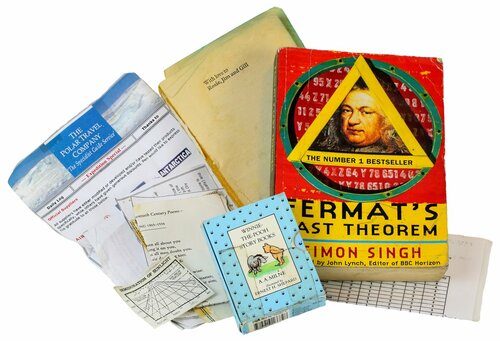Details
[FERMAT, Pierre de (1607-1665)] – DIOPHANTUS of Alexandria (fl. 3rd century CE). Arithmeticorum libri sex, et de numeris multangulis liber unus. Cum commentariis C.G. Bacheti V.C. & observationibus D. P. de Fermat. Toulouse: Bernard Bosc, 1670.
First edition of Fermat’s annotated Diophantus, containing his last theorem, the most famous problem in mathematics. "Fermat was the first European to make extensive contributions to the theory of numbers, taking up the challenge in number theory posed in Diophantus’s Arithmetica. Fermat owned a copy of the Greek editio princeps of Diophantus’s work (1621), edited and annotated by Claude Bachet de Méziriac and published with Xylander’s Latin translation; Fermat often took issue with Bachet’s statements, writing his own results for the most part in the margins of his copy. Five years after Fermat’s death, his son Claude-Samuel published a second edition of Bachet’s Diophantus, adding to it his father’s marginal notes; these included the famous note stating the still-unproved “theorem” regarding the impossibility of finding a positive integer n 2 for which the equation xn + yn = zn holds true for the positive integers x, y, and z. Fermat claimed in his note to have discovered a “very wonderful demonstration” (demonstratio sane mirabilis) of this theorem that the margin was too narrow to contain, a claim that has tantalized mathematicians ever since" (Norman). The infamous last theorem went unsolved—but stimulating many developments in mathematics—until 1995, when it was cracked by Andrew Wiles in collaboration with several other mathematicians. A few extant copies contain a portrait or errata leaf, not present here, both of which seem to have been issued somewhat later. Norman 777.
Folio (337 x 222mm). Engraved vignette on title and two engraved headpieces (outer margin of title and first leaf of dedication slightly frayed, some marginal water-staining on a few initial gatherings, some occasional light browning). Contemporary vellum, manuscript title on spine. Provenance: two inscriptions on title, “Giuse Spirito” and “Antonio Cosintino.”
Details
[FERMAT, Pierre de (1607-1665)] – DIOPHANTUS of Alexandria (fl. 3rd century CE). Arithmeticorum libri sex, et de numeris multangulis liber unus. Cum commentariis C.G. Bacheti V.C. & observationibus D. P. de Fermat. Toulouse: Bernard Bosc, 1670.
First edition of Fermat’s annotated Diophantus, containing his last theorem, the most famous problem in mathematics. "Fermat was the first European to make extensive contributions to the theory of numbers, taking up the challenge in number theory posed in Diophantus’s Arithmetica. Fermat owned a copy of the Greek editio princeps of Diophantus’s work (1621), edited and annotated by Claude Bachet de Méziriac and published with Xylander’s Latin translation; Fermat often took issue with Bachet’s statements, writing his own results for the most part in the margins of his copy. Five years after Fermat’s death, his son Claude-Samuel published a second edition of Bachet’s Diophantus, adding to it his father’s marginal notes; these included the famous note stating the still-unproved “theorem” regarding the impossibility of finding a positive integer n 2 for which the equation xn + yn = zn holds true for the positive integers x, y, and z. Fermat claimed in his note to have discovered a “very wonderful demonstration” (demonstratio sane mirabilis) of this theorem that the margin was too narrow to contain, a claim that has tantalized mathematicians ever since" (Norman). The infamous last theorem went unsolved—but stimulating many developments in mathematics—until 1995, when it was cracked by Andrew Wiles in collaboration with several other mathematicians. A few extant copies contain a portrait or errata leaf, not present here, both of which seem to have been issued somewhat later. Norman 777.
Folio (337 x 222mm). Engraved vignette on title and two engraved headpieces (outer margin of title and first leaf of dedication slightly frayed, some marginal water-staining on a few initial gatherings, some occasional light browning). Contemporary vellum, manuscript title on spine. Provenance: two inscriptions on title, “Giuse Spirito” and “Antonio Cosintino.”
.jpg)
.jpg)





.jpg)
.jpg)
.jpg)
.jpg)
.jpg)
Testen Sie LotSearch und seine Premium-Features 7 Tage - ohne Kosten!
Lassen Sie sich automatisch über neue Objekte in kommenden Auktionen benachrichtigen.
Suchauftrag anlegen